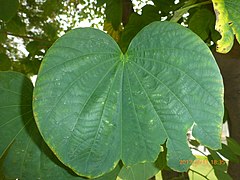bio.wikisort.org - Plant
Bauhinia purpurea is a species of flowering plant in the family Fabaceae, native to the Indian subcontinent and Myanmar, and widely introduced elsewhere in tropical and subtropical areas of the world.[1] Common names include orchid tree,[2] purple bauhinia,[2] camel's foot,[2] butterfly tree,[2] and Hawaiian orchid tree.[citation needed]
| Bauhinia purpurea | |
|---|---|
 | |
| Tree with fruits from Mindanao, Philippines | |
 | |
| Flower at Andhra Pradesh, India | |
| Scientific classification | |
| Kingdom: | Plantae |
| Clade: | Tracheophytes |
| Clade: | Angiosperms |
| Clade: | Eudicots |
| Clade: | Rosids |
| Order: | Fabales |
| Family: | Fabaceae |
| Genus: | Bauhinia |
| Species: | B. purpurea |
| Binomial name | |
| Bauhinia purpurea | |
| Synonyms[1] | |
| |
Description
Bauhinia purpurea is a small to medium-size deciduous tree growing to 17 feet (5.2 m) tall. The leaves are 10–20 centimetres (3.9–7.9 in) long and broad, rounded, and bilobed at the base and apex. The flowers are conspicuous, pink, and fragrant, with five petals. The fruit is a pod 30 centimetres (12 in) long, containing 12 to 16 seeds. Leaves are alternate.
Cultivation
In the United States of America, the tree grows in Hawaii, coastal California, southern Texas, and southwest Florida. Bauhinia × blakeana is usually propagated by grafting it onto B. purpurea stems.
Uses
The young leaves and flowers of Bauhinia purpurea are edible.[3] In the Philippines, B. purpurea is known as alibangbang (lit. "butterfly"). The leaves have a citrusy and sour taste and are used as a souring agent for sinigang and similar dishes in Philippine cuisine.[4][5]
Throughout Southeast Asia, B. purpurea and related species are also used in making poultices for treating swelling, bruises, boils, and ulcers. Various parts of the plant are also used in decoctions to treat fever and stomach ailments, as well as being used as an astringent.[3]
In Indian traditional medicine, the leaves are used to treat coughs while the bark is used for glandular diseases and as an antidote for poisons. The flowers are also used in pickles and curries and is regarded as a laxative.[3] It is called Kānchan ( কাঞ্চন) in Assamese , Odia and in Bengali.
Chemistry
A wide range of chemical compounds have been isolated from Bauhinia purpurea including 5,6-dihydroxy-7-methoxyflavone 6-O-β-D-xylopyranoside, bis [3',4'-dihydroxy-6-methoxy-7,8-furano-5',6'-mono-methylalloxy]-5-C-5-biflavonyl and (4'-hydroxy-7-methyl 3-C-α-L-rhamnopyranosyl)-5-C-5-(4'-hydroxy-7-methyl-3-C-α-D-glucopyranosyl) bioflavonoid, bibenzyls, dibenzoxepins, mixture of phytol fatty esters, lutein, β-sitosterol, isoquercitin and astragalin.[citation needed]
Gallery
- Leaf
- Bark
- Flowers
References
- "Bauhinia purpurea L." Plants of the World Online. Royal Botanic Gardens, Kew. Retrieved 2020-05-27.
- "Bauhinia purpurea". Germplasm Resources Information Network (GRIN). Agricultural Research Service (ARS), United States Department of Agriculture (USDA). Retrieved 2 January 2018.
- "Bauhinia purpurea" (PDF). Agroforestree database. World Agroforestry Centre. Retrieved 26 November 2019.
- "Alibangbang / Malabar Bauhinia". Market Manila. 7 August 2006. Retrieved 26 November 2019.
- Vanzi, Sol (17 August 2017). "Sinigang secrets: Sinigang is life". Manila Bulletin. Retrieved 26 November 2019.
External links
 Media related to Bauhinia purpurea at Wikimedia Commons
Media related to Bauhinia purpurea at Wikimedia Commons- Phanera purpurea L., Purple camel's foot
На других языках
- [en] Bauhinia purpurea
[es] Bauhinia purpurea
El urape púrpura (Bauhinia purpurea) es un árbol de la familia de las fabáceas, ampliamente difundido en las regiones tropicales de América. En Costa Rica se le conoce como casco de venado, pata de vaca u orquídea de palo.Другой контент может иметь иную лицензию. Перед использованием материалов сайта WikiSort.org внимательно изучите правила лицензирования конкретных элементов наполнения сайта.
WikiSort.org - проект по пересортировке и дополнению контента Википедии


